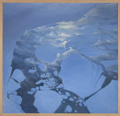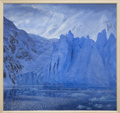As you continue moving through the exhibition, take in the view of Columbia Glacier on your right. Columbia Glacier is a large tidewater glacier originating in the snowfields northwest of Prince William Sound. In the late 1970s, when David first saw it, the glacier face was so close to the Valdez-Whittier Marine Highway route that the ferry would often swing into the bay so passengers could catch a glimpse of it. Over the decades, the glacier has retreated about 12 miles into Columbia Bay, and now the branches that used to come together to form Columbia Glacier have become separate glaciers.
In the grouping of 10 paintings in the corner, David presents a view of Columbia Bay and Glacier stretching from the west side entrance of the bay on your left, to views of the glacier in the middle, and ending with the east side of Columbia Bay on your right. The larger paintings on the bottom reflect the landscape as it was in 2011, while the smaller paintings stacked on top show the glacial retreat in 2022, a decade later.
In 2011, the face of Columbia Glacier had retreated over ten miles since David first saw it in the late 1970s, but still existed as a continuous wall of ice about 100 feet high surrounding most of the bay. By 2022, the glacier face had retreated five more miles.
This significant change in a little over a decade is remarkable not only because the glacier face had retreated so quickly, but also because glaciers that draped the mountains had thinned by hundreds of feet.
Please proceed to audio tour location 4.







